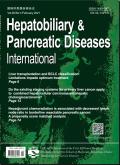Vascular reconstruction provides short-term and long-term survival benefits for patients with hilar cholangiocarcinoma: A retrospective, multicenter study
IF 4.4
3区 医学
Q2 GASTROENTEROLOGY & HEPATOLOGY
Hepatobiliary & Pancreatic Diseases International
Pub Date : 2024-12-01
DOI:10.1016/j.hbpd.2024.05.001
引用次数: 0
Abstract
Background
In patients with hilar cholangiocarcinoma (HCCA), radical resection can be achieved by resection and reconstruction of the vasculature. However, whether vascular reconstruction (VR) improves long-term and short-term prognosis has not been demonstrated comprehensively.
Methods
This was a retrospective multicenter study of patients who received surgery for HCCA with or without VR. Variables associated with overall survival (OS) and recurrence-free survival (RFS) were identified based on Cox regression. Kaplan-Meier curves were used to explore the impact of VR. Restricted mean survival time (RMST) was used for comparisons of short-term survival between the groups. Patients’ intraoperative and postoperative characteristics were compared.
Results
Totally 447 patients were enrolled. We divided these patients into 3 groups: VR with radical resections (n = 84); non-VR radical resections (n = 309) and non-radical resection (we pooled VR-nonradical and non-VR nonradical together, n = 54). Cox regression revealed that carbohydrate antigen 242 (CA242), vascular invasion, lymph node metastasis and poor differentiation were independent risk factors for OS and RFS. There was no significant difference of RMST between the VR and non-VR radical groups within 12 months after surgery (10.18 vs. 10.76 mon, P = 0.179), although the 5-year OS (P < 0.001) and RFS (P < 0.001) were worse in the VR radical group. The incidences of most complications were not significantly different, but those of bile leakage (P < 0.001) and postoperative infection (P = 0.009) were higher in the VR radical group than in the non-VR radical group. Additionally, the levels of alanine aminotransferase (ALT) and aspartate aminotransferase (AST) up to 7 days after surgery tended to decrease in all groups. There was no significant difference in the incidence of postoperative liver failure between the VR and non-VR radical groups.
Conclusions
Radical resection can be achieved with VR to improve the survival rate without worsening short-term survival compared with resection with non-VR. After adequate assessment of the patient's general condition, VR can be considered in the resection.
血管重建为肝门部胆管癌患者带来短期和长期生存益处:一项回顾性多中心研究。
背景:对于肝门部胆管癌(HCCA)患者,可通过切除和重建血管实现根治性切除。然而,血管重建(VR)是否能改善长期和短期预后尚未得到全面证实:这是一项回顾性多中心研究,研究对象为接受或未接受血管重建手术的 HCCA 患者。方法:这是一项回顾性多中心研究,研究对象为接受 HCCA 手术并行或未行 VR 的患者。根据 Cox 回归确定了与总生存期(OS)和无复发生存期(RFS)相关的变量。采用 Kaplan-Meier 曲线探讨 VR 的影响。限制平均生存时间(RMST)用于比较两组患者的短期生存率。比较了患者的术中和术后特征:共有 447 名患者入组。我们将这些患者分为三组:根治性切除的 VR 组(n = 84);非 VR 根治性切除组(n = 309)和非根治性切除组(我们将 VR 非根治性切除组和非 VR 非根治性切除组集中在一起,n = 54)。Cox回归显示,碳水化合物抗原242(CA242)、血管侵犯、淋巴结转移和分化不良是影响OS和RFS的独立危险因素。VR根治组和非VR根治组术后12个月内的RMST无明显差异(10.18 mon vs. 10.76 mon,P = 0.179),但VR根治组的5年OS(P < 0.001)和RFS(P < 0.001)较差。大多数并发症的发生率无明显差异,但VR根治术组的胆漏(P < 0.001)和术后感染(P = 0.009)发生率高于非VR根治术组。此外,各组术后 7 天内的丙氨酸氨基转移酶(ALT)和天冬氨酸氨基转移酶(AST)水平均呈下降趋势。VR组和非VR根治组的术后肝功能衰竭发生率无明显差异:结论:与非VR根治术相比,VR根治术可提高存活率,且不会恶化短期存活率。在充分评估患者的一般情况后,可以考虑在切除术中使用 VR。
本文章由计算机程序翻译,如有差异,请以英文原文为准。
求助全文
约1分钟内获得全文
求助全文
来源期刊
CiteScore
5.40
自引率
6.10%
发文量
152
审稿时长
3.0 months
期刊介绍:
Hepatobiliary & Pancreatic Diseases International (HBPD INT) (ISSN 1499-3872 / CN 33-1391/R) a bimonthly journal published by First Affiliated Hospital, Zhejiang University School of Medicine, China. It publishes peer-reviewed original papers, reviews and editorials concerned with clinical practice and research in the fields of hepatobiliary and pancreatic diseases. Papers cover the medical, surgical, radiological, pathological, biochemical, physiological and historical aspects of the subject areas under the headings Liver, Biliary, Pancreas, Transplantation, Research, Special Reports, Editorials, Review Articles, Brief Communications, Clinical Summary, Clinical Images and Case Reports. It also deals with the basic sciences and experimental work. The journal is abstracted and indexed in SCI-E, IM/MEDLINE, EMBASE/EM, CA, Scopus, ScienceDirect, etc.

 求助内容:
求助内容: 应助结果提醒方式:
应助结果提醒方式:


